Google Ads are no longer a novelty for businesses wanting to build an online presence and achieve measurable results.
With millions of advertisers competing for attention, understanding and monitoring Google Ads metrics is crucial for running successful campaigns.
But what exactly are these metrics, and why do they matter?
This article will guide you through mastering Google Ads metrics to optimize your campaigns, maximize ROIReturn on Investment, a performance metric used to evaluate the efficiency of an investment., and stay ahead in this competitive digital landscape.
- Understanding Key Google Ads Metrics
- Top Metrics for Measuring Campaign Performance
- Measuring Audience Engagement with Google Ads
- Advanced Strategies for Monitoring Metrics
- Improving Campaign Results Through Metric Optimization
- Google Ads Metrics for Campaign Success
- Google Ads Metrics: Frequently Asked Questions
Understanding Key Google Ads Metrics
Google Ads metrics are the backbone of your campaign’s performance.
They provide insights into how your ads are performing, what’s working, and where adjustments are needed.
Without understanding these key metrics, it’s like driving a car without knowing your speed or fuel level—you simply can’t make informed decisions.

A detailed illustration of Google Ads metrics represented through analytics dashboards and performance indicators.
What Are Google Ads Metrics?
Google Ads metrics are data points that measure the effectiveness of your advertising efforts.
They help you track user behavior, ad visibility, and the return on your advertising investment.
These metrics range from click-through rates to conversion rates, each serving a unique purpose in your campaign.
An illustration highlighting the significance of tracking Google Ads metrics through analytics and performance indicators.
The Importance of Tracking Metrics
Tracking Google Ads metrics is not just about numbers; it’s about understanding how your ads resonate with your target audience.
Metrics can reveal:
- Whether your ad copy and visuals are compelling enough to attract clicks.
- How effectively your landing pages convert visitors into customers.
- Whether your budget is being utilized effectively or wasted on irrelevant clicks.
By closely monitoring these metrics, you can identify what works and continuously improve your campaigns.

An illustration showcasing the pitfalls of misinterpreting Google Ads metrics through cluttered dashboards and warning symbols.
Common Mistakes in Understanding Metrics
While metrics are invaluable, interpreting them incorrectly can lead to poor decisions.
Some common mistakes include:
- Focusing too much on vanity metrics like impressions without considering conversions.
- Ignoring Quality Score, which affects your ad placement and costs.
- Failing to segment data, resulting in misleading insights.
Avoid these pitfalls by regularly reviewing your campaign data with a critical eye.

An illustration emphasizing the importance of understanding key Google Ads terms through analytics and symbolic icons.
Key Terms You Need to Know
Before diving deeper, familiarize yourself with some essential Google Ads terms:
- Click-Through Rate (CTR): The percentage of users who click your ad after seeing it.
- Conversion Rate: The percentage of users who complete a desired action, like making a purchase.
- Cost Per Click (CPC): The amount you pay each time someone clicks on your ad.
- Quality Score: A measurement of the relevance and quality of your ad and landing page.
Understanding these terms is the first step toward mastering Google Ads metrics and driving campaign success.
Google Ads metrics are essential for understanding campaign performance, providing actionable insights to optimize strategies and improve ROI.

An illustration depicting key metrics for measuring campaign performance in Google Ads through detailed analytics dashboards.
Top Metrics for Measuring Campaign Performance
When running a Google Ads campaign, knowing which metrics to monitor can make all the difference in achieving your goals.
The right metrics provide actionable insights into your campaign’s effectiveness and help you make data-driven decisions.
Let’s dive into the top Google Ads metrics that you should focus on to measure your campaign performance and improve your results.

An illustration showcasing the significance of Click-Through Rate (CTR) through analytics and performance trends.
Click-Through Rate (CTR): Why It Matters
The Click-Through Rate (CTR) is one of the most important Google Ads metrics.
It represents the percentage of users who click on your ad after seeing it.
A high CTR indicates that your ad is engaging and relevant to your target audience.
- Formula: CTR = (Total Clicks / Total Impressions) × 100
- Impact: A higher CTR can improve your Quality Score, lowering your cost-per-click (CPC) and improving ad placement.
To improve your CTR, focus on creating compelling ad copy, using high-quality visuals, and leveraging keywords that align with user intent.
An illustration highlighting the importance of tracking conversion rates through detailed analytics and goal-oriented insights.
Conversion Rate: Tracking Results
The Conversion Rate is the percentage of users who take a desired action, such as making a purchase or filling out a form, after clicking your ad.
It’s a key indicator of how effectively your ads drive business outcomes.
- Formula: Conversion Rate = (Total Conversions / Total Clicks) × 100
- Impact: A high conversion rate reflects the effectiveness of your landing page and overall campaign strategy.
Optimize your landing pages by ensuring they are mobile-friendly, load quickly, and feature clear calls to action (CTAs).
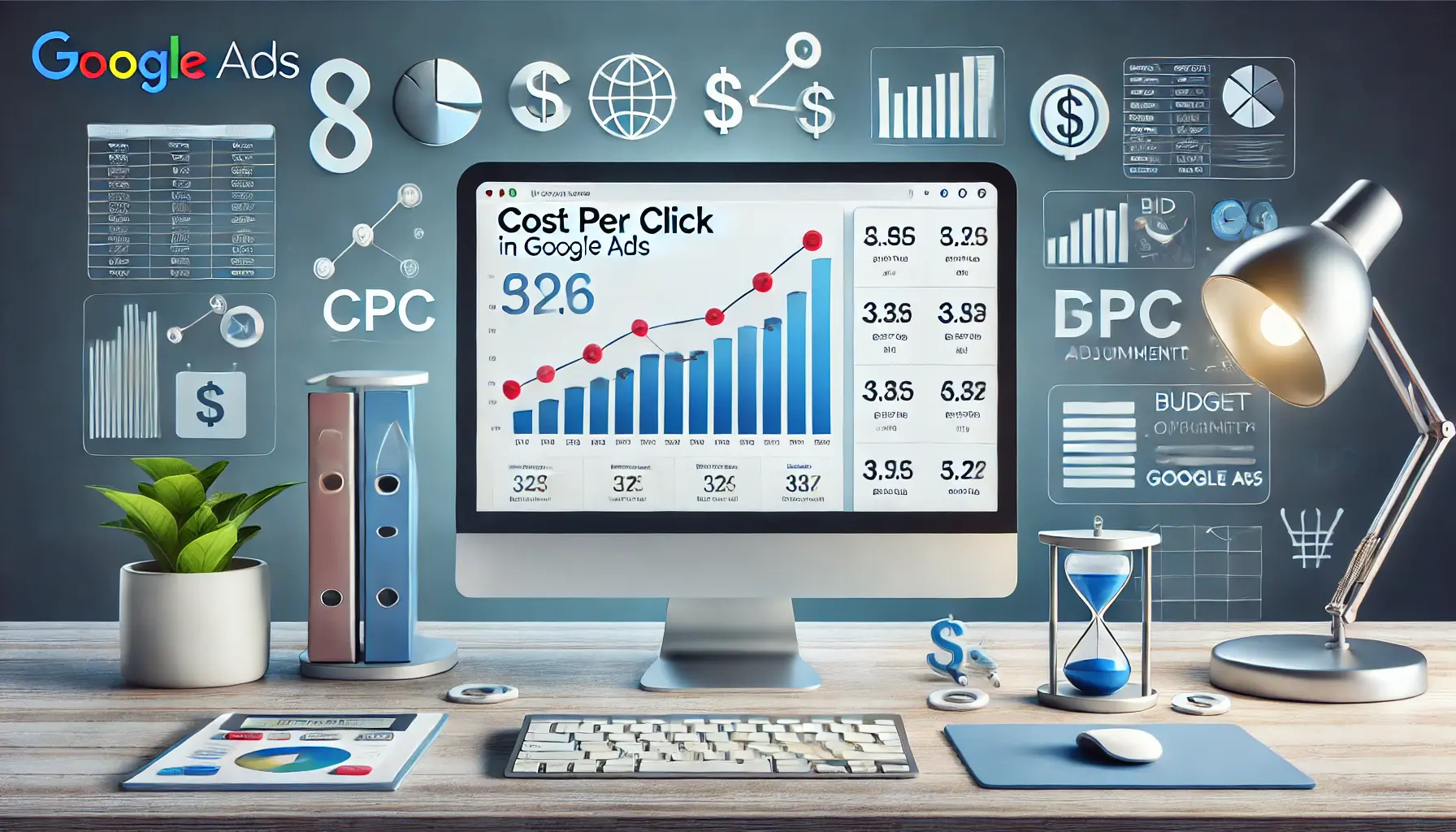
An illustration emphasizing budget optimization through detailed analysis of Cost Per Click (CPC) metrics.
Cost Per Click (CPC): Optimizing Your Budget
Cost Per Click (CPC) measures how much you pay for each click on your ad.
This metric helps you evaluate the cost-effectiveness of your campaigns and manage your budget efficiently.
- Impact: Lower CPC means you can achieve more clicks within your budget.
- Factors Influencing CPC: Bidding strategy, competition for keywords, and Quality Score.
To reduce CPC, focus on improving your Quality Score and targeting less competitive but highly relevant keywords.
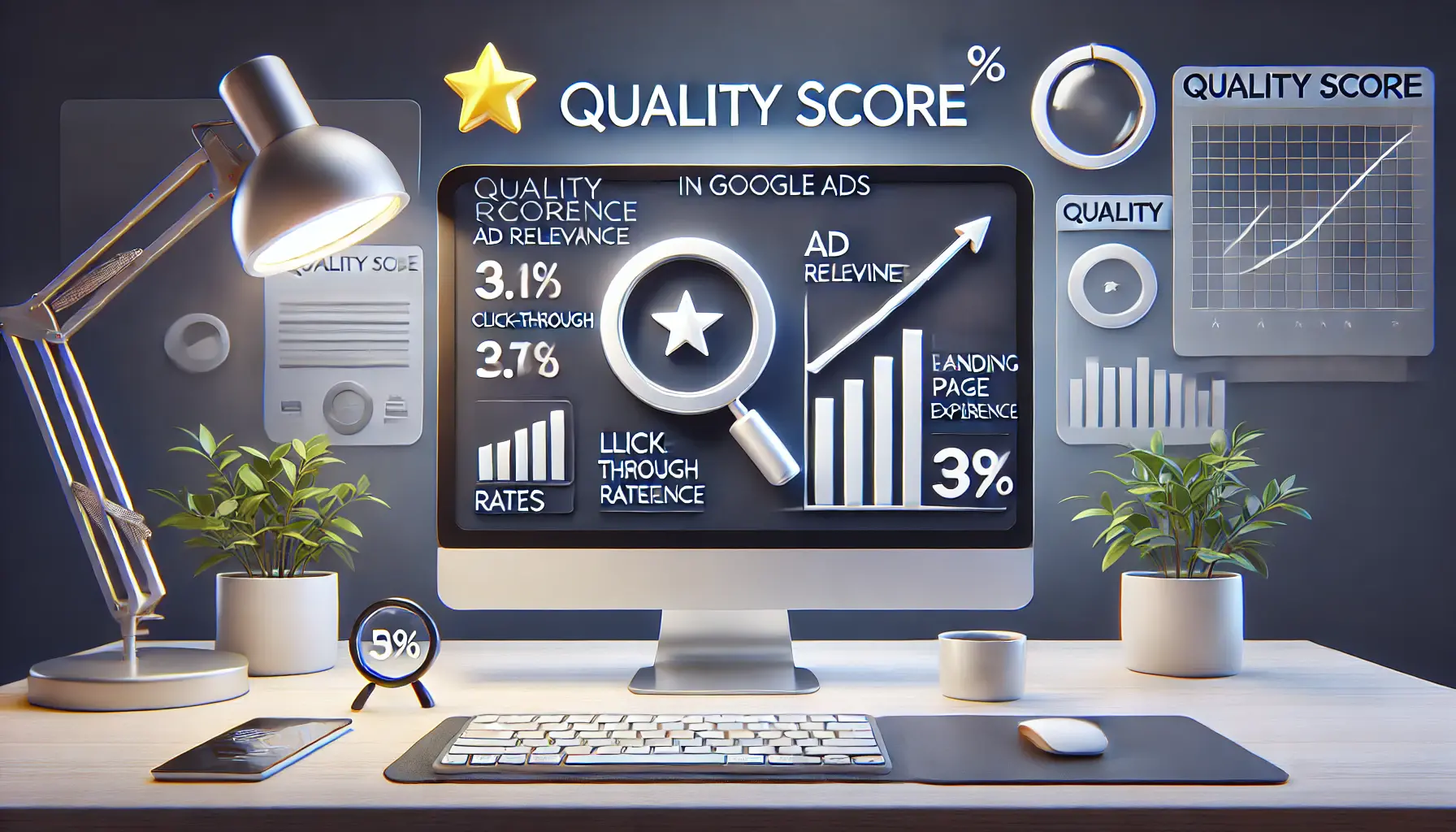
An illustration showcasing the importance of Quality Score in optimizing ad relevance and performance.
Quality Score: Enhancing Ad Relevance
Quality Score is a Google Ads metric that evaluates the relevance and quality of your ad copy, keywords, and landing page.
It’s scored on a scale of 1 to 10, with 10 being the highest.
- Components: Expected CTR, ad relevance, and landing page experience.
- Impact: A higher Quality Score lowers CPC and improves ad placement.
To boost your Quality Score, focus on creating highly targeted ad groups, aligning ad copy with keywords, and ensuring your landing page matches user expectations.
With these top metrics, you’ll be able to measure the effectiveness of your Google Ads campaigns and make informed decisions that lead to better outcomes.
Focus on metrics like CTR, conversion rate, CPC, and Quality Score to make informed decisions and achieve campaign goals effectively.

An illustration highlighting the importance of measuring audience engagement through detailed analytics in Google Ads.
Measuring Audience Engagement with Google Ads
Knowing how your audience engages with your ads is an essential part of managing a successful campaign.
Google Ads provides powerful tools for measuring audience engagement, offering insights into how to refine your strategy, improve your messaging, and achieve better results.
Let’s take a look at some key metrics and strategies to measure and enhance audience engagement.
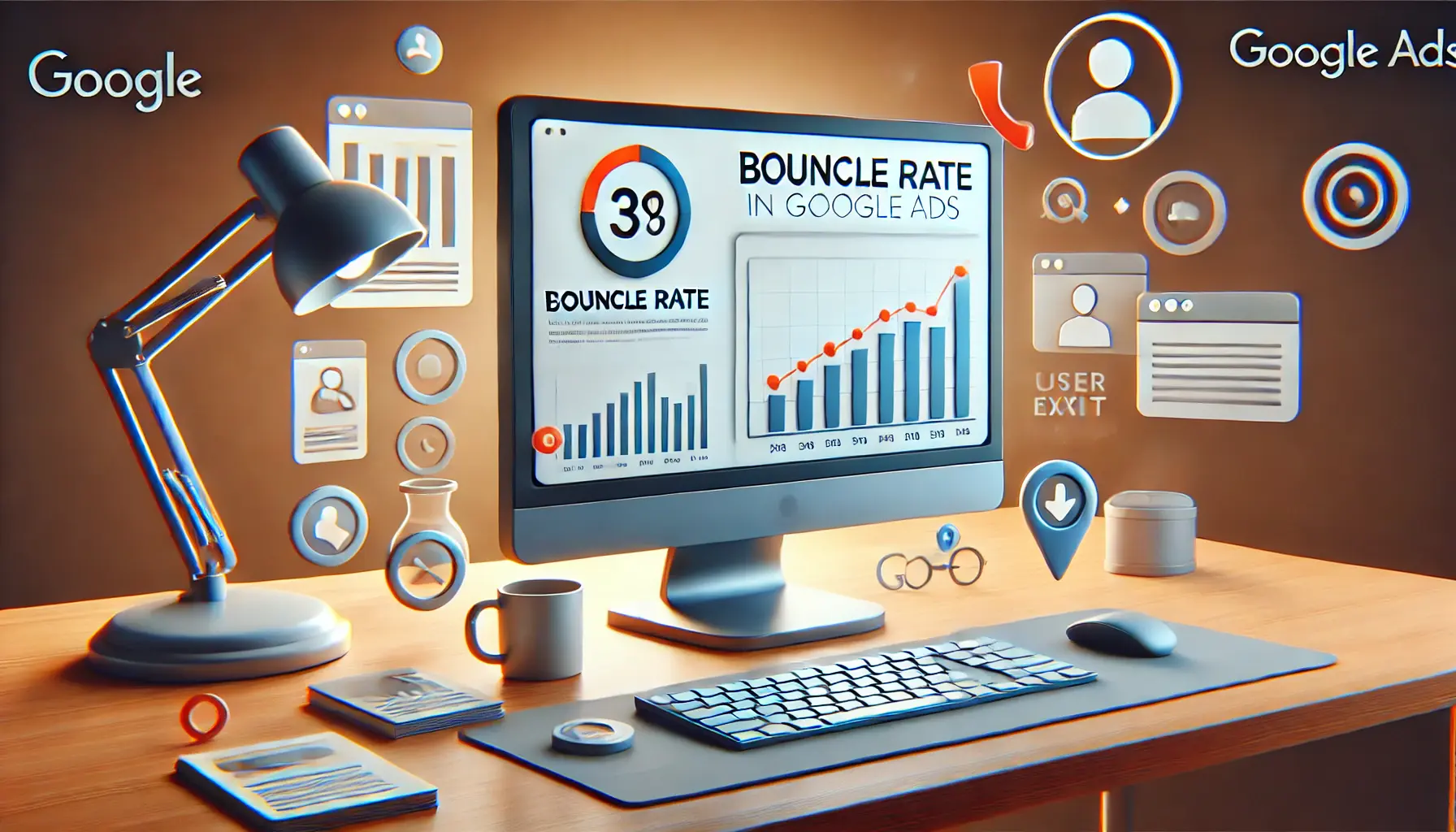
An illustration highlighting the importance of measuring bounce rates to assess engagement levels in Google Ads campaigns.
Bounce Rate: Measuring Engagement Levels
Bounce rate measures the percentage of visitors to your landing page who leave without completing a conversion event, such as clicking a link or filling out a form.
A high bounce rate may indicate that your landing page or ad doesn’t appeal to the audience.
- Solution: Ensure your landing page is fast-loading, visually appealing, and aligned with the ad’s message.
Monitor your bounce rate regularly to identify trends and adjust your strategy accordingly.

An illustration emphasizing the importance of Impression Share in measuring ad reach and visibility within Google Ads campaigns.
Impression Share: Measuring Ad Reach
Impression share is the percentage of total impressionsThe number of times your ad is displayed to users. your ad receives compared to the total available impressions in the market.
It’s a valuable metric to understand how well your ads are competing.
- Formula: Impression Share = (Your Impressions / Total Available Impressions) × 100
- Impact: A low impression share may indicate that your budget or bid is too low.
- Solution: Increase your budget or refine your targeting to maximize impression share.
Improving your impression share helps you capture more of your target audience’s attention.

An illustration emphasizing the importance of demographic and location insights for optimizing Google Ads campaigns.
Demographics and Location Insights
Google Ads delivers detailed demographic and location insights, helping you understand who is engaging with your ads and where they are located.
These insights allow you to fine-tune your targeting to deliver more personalized messages.
- Demographic Key Metrics: Age, gender, parental status, and household income.
- Location Data: Identifies regions or cities where your ads perform best.
Apply the findings to your ad copy, visuals, and targeting to align with your most engaged audience segments.

An illustration showcasing the importance of audience segmentation for optimizing Google Ads campaign performance.
Segmenting for Better Performance
Segmenting your audience is a key strategy for achieving better engagement.
By grouping users based on shared characteristics or behaviors, you can create highly specific campaigns that speak directly to their needs and interests.
- Examples of Segments: New customers, returning customers, and users who abandoned carts.
- Impact: Segmentation increases the relevance of your ads, improving CTR and conversions.
Implement audience segmentationDividing an audience into smaller groups based on specific criteria like behavior or demographics. in your campaigns to deliver tailored messages and maximize engagement.
By leveraging these engagement metrics and strategies, you can gain deeper insights into your audience’s behavior, refine your campaigns, and achieve better results with Google Ads.
Engagement metrics like bounce rate, impression share, and demographic insights are crucial for understanding and improving audience interaction with your ads.

An illustration depicting advanced strategies and tools for monitoring and optimizing Google Ads campaign metrics.
Advanced Strategies for Monitoring Metrics
Once you’ve mastered the basics of Google Ads metrics, it’s time to explore advanced strategies that can take your campaigns to the next level.
These strategies leverage tools, techniques, and data analysis to provide deeper insights and more effective decision-making, ensuring you stay ahead of the competition.

An illustration showcasing the use of Google Analytics for gaining deeper insights into Google Ads performance and user behavior.
Leveraging Google Analytics for Deeper Insights
Google Analytics is a powerful complement to Google Ads that provides in-depth insights into user behavior on your website.
By integrating Google Analytics with your Google Ads account, you can track key actions such as time spent on your site, pages viewed, and conversion paths beyond ad clicks.
- Benefits: You get a holistic view of user behavior from ad click to conversion.
- Key Features: Custom reports, real-time data, and audience insights.
Use these insights to optimize your campaigns by identifying high-performing keywords, audiences, and landing pages.
An illustration showcasing the use of automated reports for tracking Google Ads performance efficiently.
Using Automated Reports for Efficient Tracking
Manual tracking can be time-consuming, especially for large campaigns.
Automated reports streamline the process by delivering regular updates on your metrics directly to your inbox or dashboard.
- Advantages: Save time and ensure consistency in tracking.
- Customizations: Set up reports to focus on specific metrics like CTR, CPC, and conversion rates.
Automated reporting helps you stay informed and make timely adjustments to your campaigns.

An illustration depicting the A/B testing process in Google Ads, comparing two versions of ads or landing pages.
A/B Testing: Refining Campaign Effectiveness
A/B testing, also known as split testing, is one of the most effective ways to determine how different versions of an ad or landing page perform against each other.
You can find out what really works for your audience by testing variables such as headlines, images, or calls to action.
- Create two versions of your ad or landing page with one variable changed.
- Run both versions simultaneously to a similar audience.
- Analyze the results to identify the best-performing version.
Impact: A/B testingA method of comparing two versions of an ad or webpage to see which performs better. provides data-driven insights to refine your campaigns and boost performance.

An illustration showcasing the integration of third-party tools with Google Ads for advanced metric analysis.
Integrating Third-Party Tools for Metric Analysis
While Google Ads and Google Analytics are powerful tools, third-party tools can provide even more value by offering advanced analytics, competitor insights, and campaign management capabilities.
- Examples of Tools: SEMrush, Ahrefs, Optmyzr, and HubSpot.
- Benefits: Access additional data, automate complex tasks, and gain a competitive edge.
Explore these tools to enhance your metric monitoring and uncover hidden opportunities for improvement.
By using such sophisticated strategies, you can obtain greater insights from your campaigns, optimize your processes, and achieve superior results with Google Ads.
Implement strategies such as integrating Google Analytics, A/B testing, and using third-party tools to gain deeper insights and enhance campaign effectiveness.

An illustration emphasizing the importance of optimizing metrics to improve campaign performance in Google Ads.
Improving Campaign Results Through Metric Optimization
Effective optimization of Google Ads metrics can significantly improve your campaign results.
By continuously refining your approach, analyzing data, and making informed decisions, you can enhance your ad performance, reduce costs, and maximize ROI.
This section explores key strategies to optimize your metrics and achieve better campaign outcomes.

An illustration highlighting the importance of setting realistic performance goals for Google Ads campaigns.
Setting Realistic Performance Goals
Before you start working on optimization, it is vital to define concrete and realistic performance objectives for your campaigns.
These should reflect your business goals and be quantifiable with Google Ads metrics.
- Examples of Goals: Increase conversion rate by 10%, reduce cost per conversion by 15%, or increase CTR by 5%.
- Why It Matters: Having clear objectives directs you toward achieving success by defining what to measure and track to assess your progress.
Start by identifying key metrics that directly impact your business and focus on achieving incremental improvements.

An illustration showcasing the importance of adjusting ad spend based on data-driven insights for Google Ads campaigns.
Ad Spend Adjustment Based on Data
Optimizing ad spend is essential to maximize ROI.
You can optimize your budget by analyzing data from your campaigns.
- Identify High-Performing Campaigns: Increase budgets for campaigns with strong CTR, conversion rates, and ROI.
- Reduce Spend on Underperformers: Reallocate budgets from campaigns with high CPC or low conversions.
Monitor your spending regularly to ensure resources are directed where they yield the best results.

An illustration showcasing the process of identifying and resolving weaknesses in Google Ads campaigns using performance data and optimization tools.
Identifying and Resolving Campaign Weaknesses
Every campaign has areas that can be improved.
Use Google Ads metrics to identify weaknesses and take corrective actions.
- Common Weaknesses: Low CTR, high bounce rates, or poor Quality Scores.
- Solutions: Rewrite ad copy, update landing pages, or adjust keyword targeting.
Testing and optimization will continually help you improve weaknesses and deliver better performance.

An illustration highlighting the importance of continuous learning and ongoing metric adjustments to optimize Google Ads performance.
Continuous Learning and Metric Adjustments
Optimization is a continuous process of learning and adjustment.
Stay updated with the latest Google Ads features, industry trends, and performance benchmarks to maintain competitive campaigns.
- Actionable Steps: Attend webinars, read industry blogs, and experiment with new ad formats or bidding strategies.
- Benefits: Continuous improvement ensures your campaigns adapt to changing market dynamics.
Keep an eye on your metrics and make incremental changes to sustain long-term success.
By focusing on metric optimization, you can transform your Google Ads campaigns into powerful tools for achieving your business objectives.
Regular analysis, adjustments, and learning will ensure you stay ahead in the competitive digital advertising landscape.
Optimizing metrics involves setting realistic goals, refining ad spend, identifying weaknesses, and making continuous adjustments for better results.
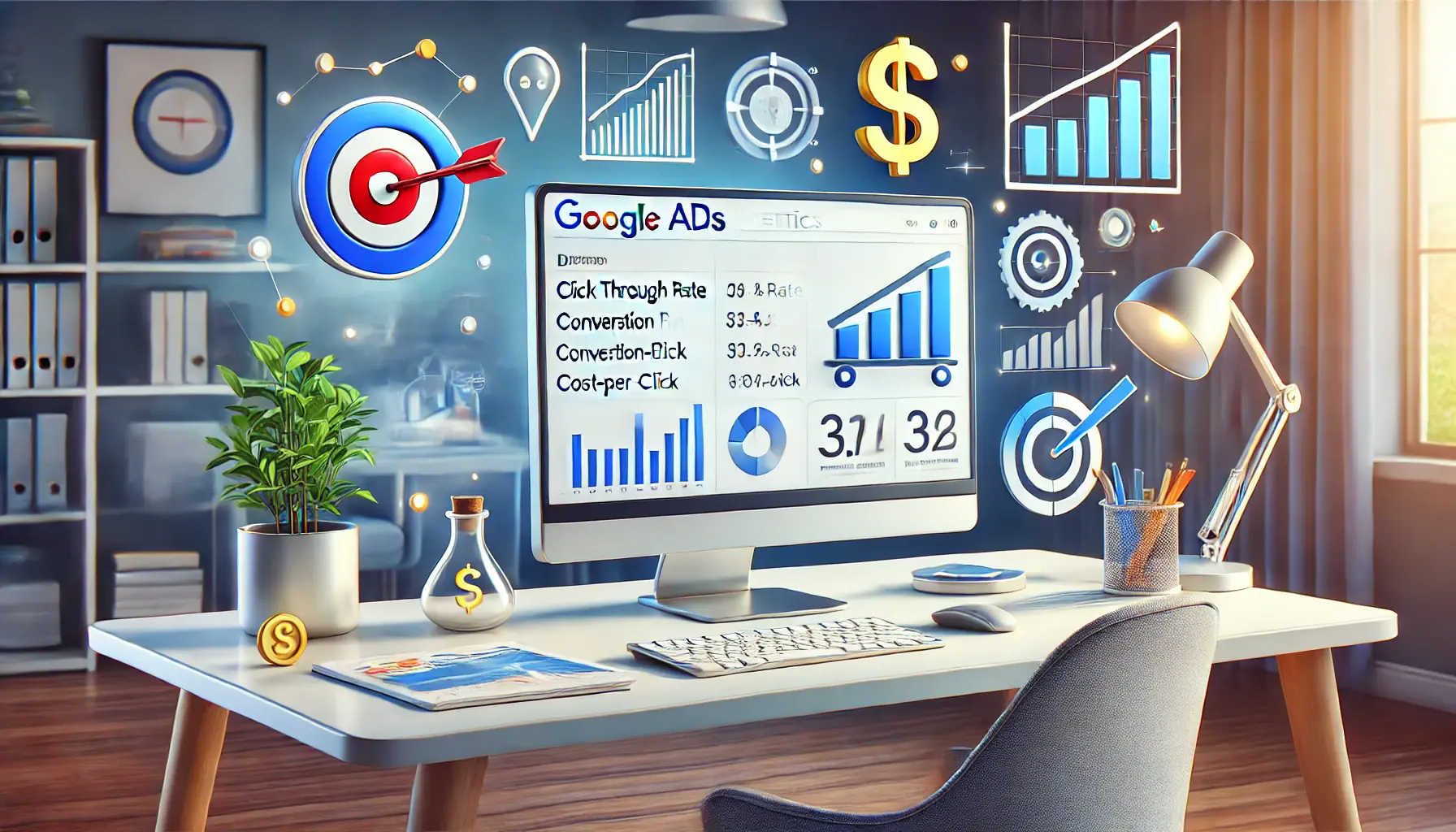
An illustration emphasizing the role of Google Ads metrics in driving campaign success and performance.
Google Ads Metrics for Campaign Success
Google Ads metrics form the core of any successful digital advertising campaign.
By understanding, analyzing, and optimizing these metrics, businesses can unlock their full potential, improve performance, and attain measurable results.
This article served as a comprehensive guide to mastering Google Ads metrics, covering foundational concepts, advanced strategies, and actionable insights.

An illustration emphasizing the importance of monitoring key metrics to optimize Google Ads campaign performance.
The Significance of Monitoring Key Metrics
Monitoring Google Ads metrics allows you to effectively assess the performance of your campaigns.
Metrics such as click-through rate (CTR), conversion rate, cost-per-click (CPC), and Quality Score provide valuable insights into user behavior and ad performance.
By focusing on these metrics, you can ensure your campaigns align with your business goals and drive meaningful results.
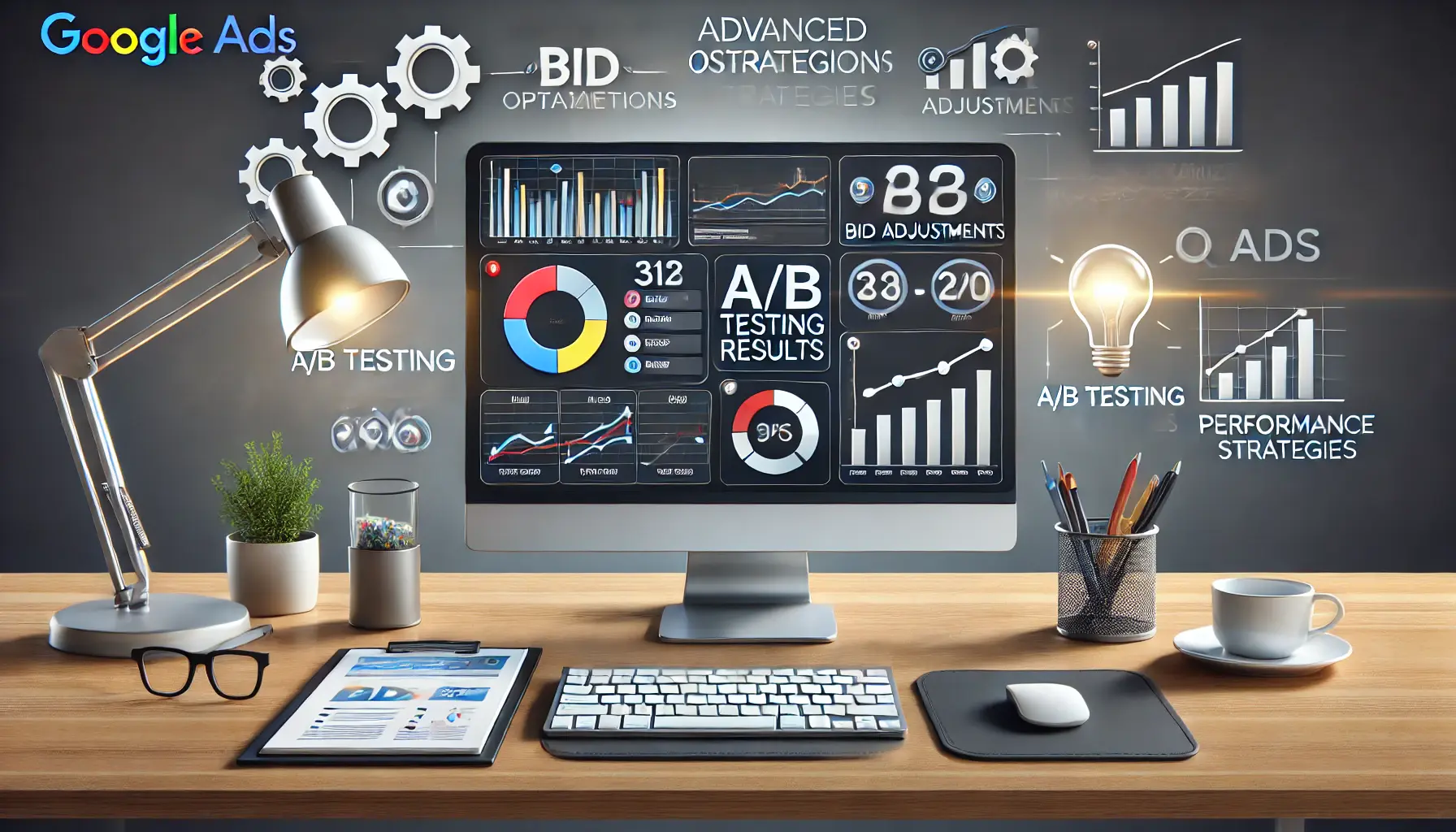
An illustration highlighting the use of advanced strategies like bid adjustments and A/B testing for optimizing Google Ads campaigns.
Advanced Strategies for Optimization
To achieve long-term success, leveraging advanced strategies is essential.
Integrating tools like Google Analytics provides a holistic view of user behavior, while automated reporting saves time and ensures consistent tracking.
A/B testing and the use of third-party tools further enhance your ability to refine campaigns and achieve better outcomes.
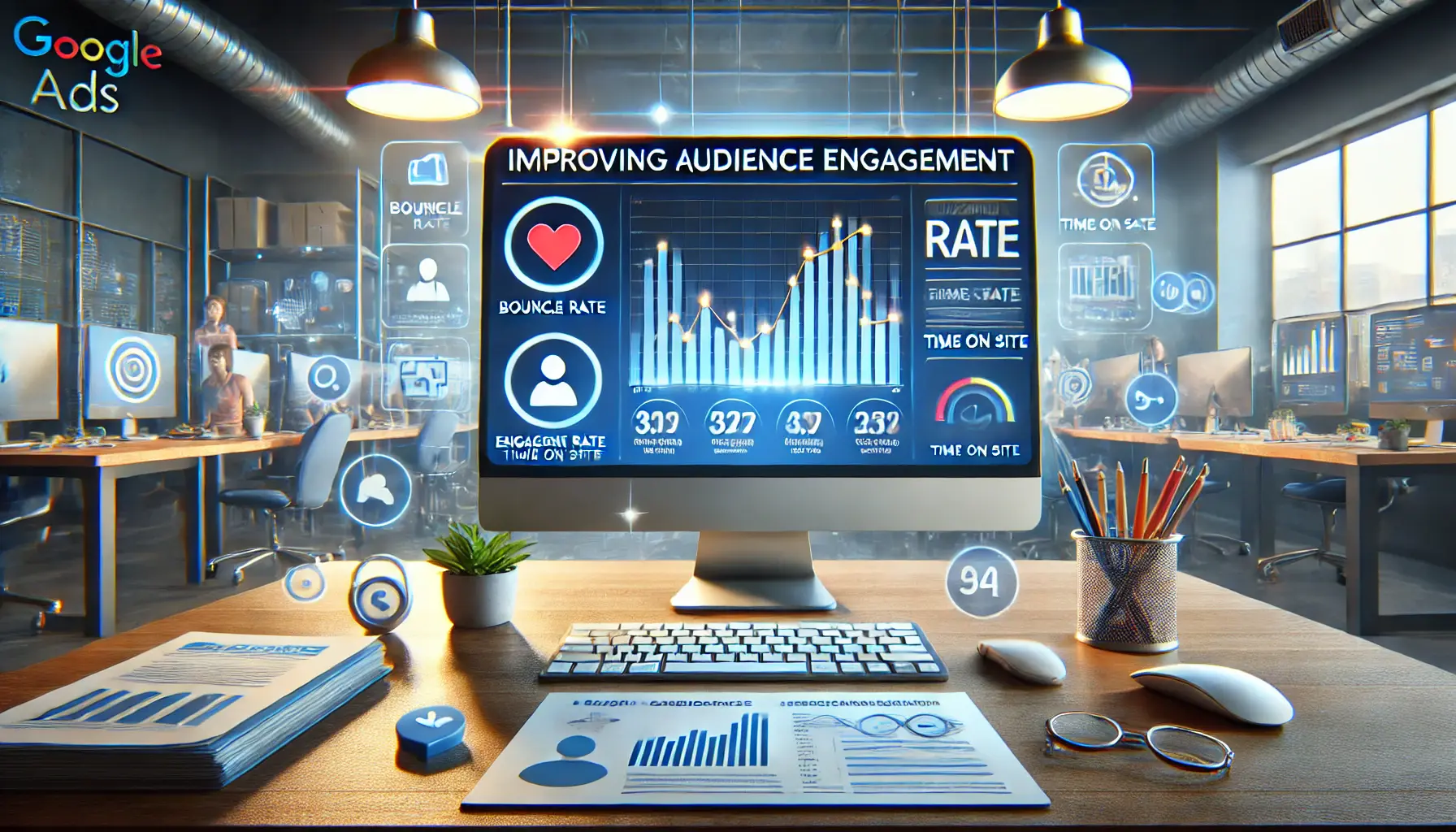
An illustration highlighting the importance of improving audience engagement through analytics and user interaction metrics.
Improving Audience Engagement
Engaging your audience is key to maximizing the impact of your ads.
Metrics such as bounce rate, impression share, and demographic insights help you understand your audience’s behavior and preferences.
By implementing segmentation and personalized targeting, you can create more relevant and impactful campaigns.

An illustration showcasing the importance of continuous learning and adaptation for optimizing Google Ads campaigns.
Continuous Learning and Adaptation
The digital advertising landscape is ever-evolving, making continuous learning and adaptation crucial.
Staying informed about the latest industry trends, experimenting with new strategies, and regularly refining your campaigns ensures that your Google Ads efforts remain competitive and effective.
In conclusion, mastering Google Ads metrics is not a one-time effort but an ongoing process of learning, testing, and optimization.
By applying the strategies and insights outlined in this article, you can transform your campaigns into powerful tools for achieving business growth and success.
Monitoring and optimizing Google Ads metrics ensures alignment with business goals, driving measurable success and staying competitive in digital advertising.
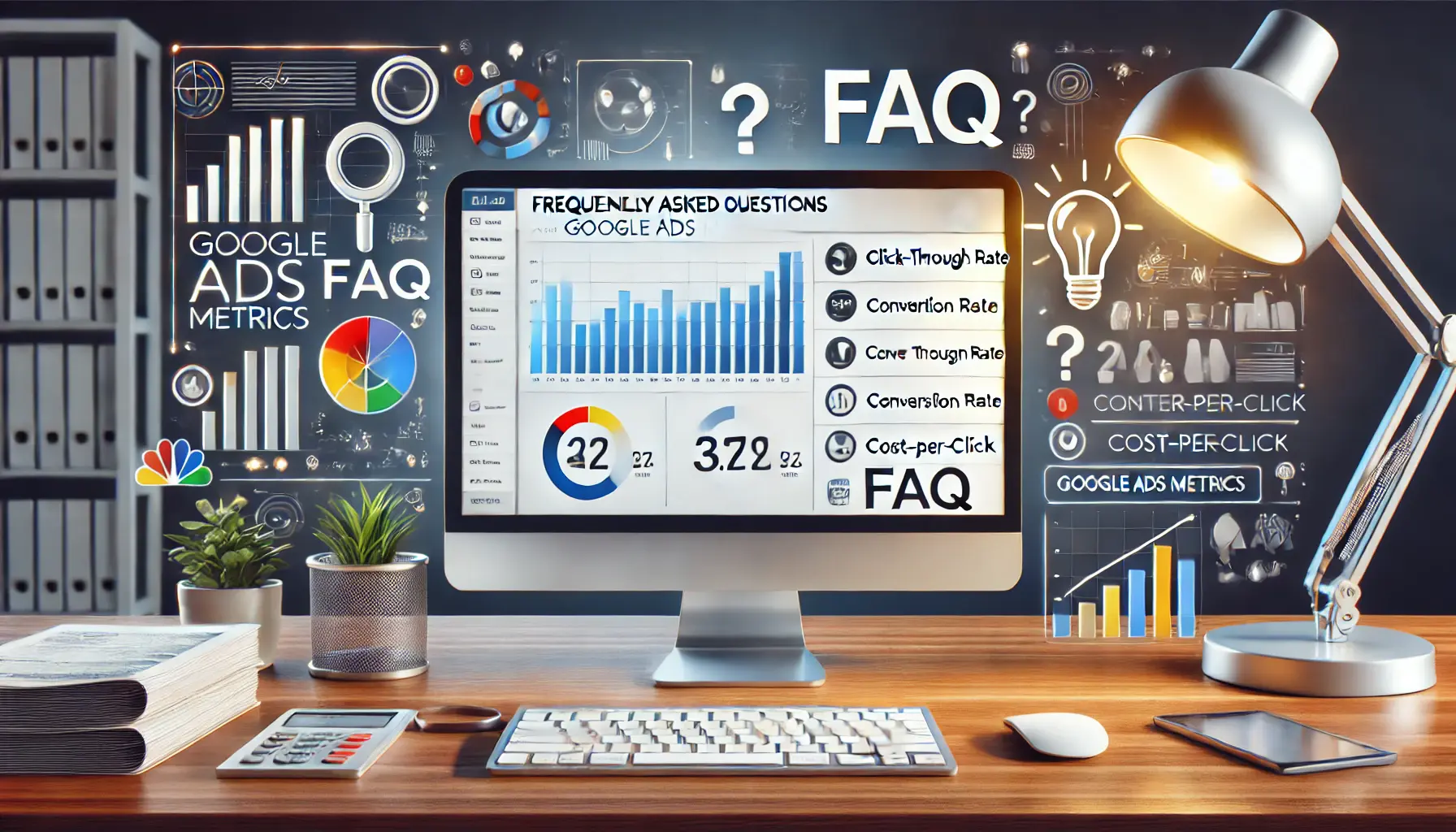
An illustration showcasing the concept of frequently asked questions (FAQ) about Google Ads metrics.
Your campaigns can be managed by an agency specialized in Google Ads, check out our service page.
Google Ads Metrics: Frequently Asked Questions
Below are some of the most commonly asked questions about Google Ads metrics and how they contribute to the success of your campaigns.
Quick answers are provided to help you understand and optimize your Google Ads strategy effectively.
The main metrics include click-through rate (CTR), conversion rate, cost-per-click (CPC), Quality Score, and impression share.
These metrics provide significant insights into campaign performance and help optimize your ads for better results.
Improve your Quality Score by using relevant ad copy, selecting keywords that match user intent, and ensuring your landing page provides a seamless experience.
Regularly refine your campaigns based on data-driven insights for improved performance.
A good CTR varies by industry but generally falls between 2% and 5%.
Regularly review ad performance to enhance targeting and creative elements, aiming to achieve a higher CTR.
A high bounce rate indicates visitors are leaving your site without engaging.
This can lower your Quality Score and ROI.
Optimize your landing pages to align with ad messaging and meet user expectations to reduce bounce rates.
Google Analytics provides deeper insights into user behavior, such as time spent on site and conversion paths.
Integrating it with Google Ads helps identify high-performing campaigns and areas needing improvement, driving better results overall.
Review your Google Ads metrics weekly for ongoing campaigns.
For high-budget or time-sensitive campaigns, daily reviews ensure quick adjustments to improve performance and address emerging issues promptly.
A/B testing compares two versions of an ad to determine which performs better.
Testing variables like headlines, visuals, and CTAs refines the campaign and improves performance based on real audience data.
Improve your Quality Score, target less competitive yet relevant keywords, and refine audience segmentation.
These strategies effectively reduce CPC while maintaining or enhancing campaign performance, maximizing your ROI.
Impression share measures the percentage of available impressions your ad receives.
It’s essential for understanding your ad’s reach and competitiveness, helping you refine budgets and targeting strategies for better visibility.














